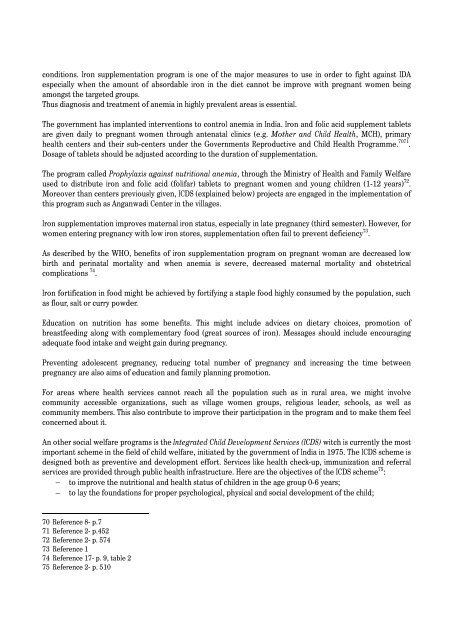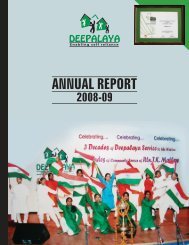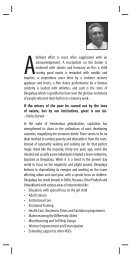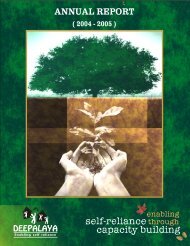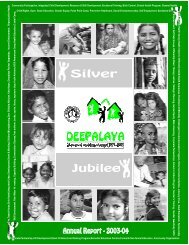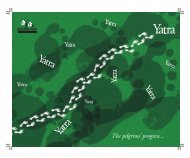Report 2011 - Deepalaya
Report 2011 - Deepalaya
Report 2011 - Deepalaya
Create successful ePaper yourself
Turn your PDF publications into a flip-book with our unique Google optimized e-Paper software.
conditions. Iron supplementation program is one of the major measures to use in order to fight against IDA<br />
especially when the amount of absordable iron in the diet cannot be improve with pregnant women being<br />
amongst the targeted groups.<br />
Thus diagnosis and treatment of anemia in highly prevalent areas is essential.<br />
The government has implanted interventions to control anemia in India. Iron and folic acid supplement tablets<br />
are given daily to pregnant women through antenatal clinics (e.g. Mother and Child Health, MCH), primary<br />
health centers and their sub-centers under the Governments Reproductive and Child Health Programme. 7071 .<br />
Dosage of tablets should be adjusted according to the duration of supplementation.<br />
The program called Prophylaxis against nutritional anemia, through the Ministry of Health and Family Welfare<br />
used to distribute iron and folic acid (folifar) tablets to pregnant women and young children (1-12 years) 72 .<br />
Moreover than centers previously given, ICDS (explained below) projects are engaged in the implementation of<br />
this program such as Anganwadi Center in the villages.<br />
Iron supplementation improves maternal iron status, especially in late pregnancy (third semester). However, for<br />
women entering pregnancy with low iron stores, supplementation often fail to prevent deficiency 73 .<br />
As described by the WHO, benefits of iron supplementation program on pregnant woman are decreased low<br />
birth and perinatal mortality and when anemia is severe, decreased maternal mortality and obstetrical<br />
complications 74 .<br />
Iron fortification in food might be achieved by fortifying a staple food highly consumed by the population, such<br />
as flour, salt or curry powder.<br />
Education on nutrition has some benefits. This might include advices on dietary choices, promotion of<br />
breastfeeding along with complementary food (great sources of iron). Messages should include encouraging<br />
adequate food intake and weight gain during pregnancy.<br />
Preventing adolescent pregnancy, reducing total number of pregnancy and increasing the time between<br />
pregnancy are also aims of education and family planning promotion.<br />
For areas where health services cannot reach all the population such as in rural area, we might involve<br />
community accessible organizations, such as village women groups, religious leader, schools, as well as<br />
community members. This also contribute to improve their participation in the program and to make them feel<br />
concerned about it.<br />
An other social welfare programs is the Integrated Child Development Services (ICDS) witch is currently the most<br />
important scheme in the field of child welfare, initiated by the government of India in 1975. The ICDS scheme is<br />
designed both as preventive and development effort. Services like health check-up, immunization and referral<br />
services are provided through public health infrastructure. Here are the objectives of the ICDS scheme 75 :<br />
− to improve the nutritional and health status of children in the age group 0-6 years;<br />
− to lay the foundations for proper psychological, physical and social development of the child;<br />
70 Reference 8- p.7<br />
71 Reference 2- p.452<br />
72 Reference 2- p. 574<br />
73 Reference 1<br />
74 Reference 17- p. 9, table 2<br />
75 Reference 2- p. 510


